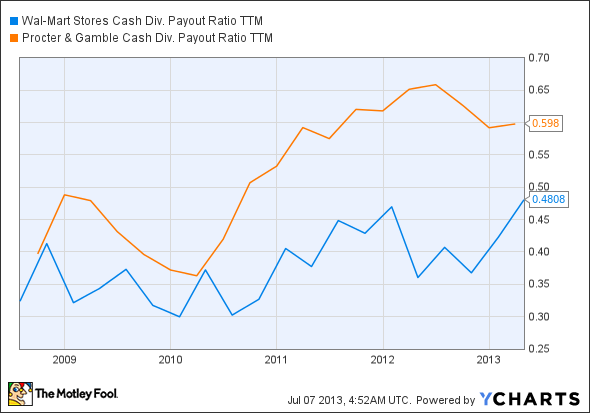Wal-Mart vs. Procter & Gamble: Which Dow Stock's Dividend Dominates?
Dividend stocks outperform non-dividend-paying stocks over the long run . It happens in good markets and bad, and the benefit of dividends can be quite striking -- dividend payments have made up about 40% of the market's average annual return from 1936 to the present day. But few of us can invest in every single dividend-paying stock on the market, and even if we could, we might find better gains by being selective. That's why we'll be pitting two of the Dow Jones Industrial Average's dividend payers against each other today to find out which Dow stock is the true dividend champion. Let's take a closer look at our two contenders now.
Tale of the tape
Wal-Mart joined the Dow in 1997, and is currently the only dedicated retailer on the index. It's also the world's largest retailer -- its 2012 annual revenue of nearly $470 billion is greater than the GDP of all but approximately 30 countries. Whether you love it, hate it, or simply appreciate the value of its stock, you can't deny the profound impact Wal-Mart's business practices have had on the world over the past 50 years.
Procter & Gamble is the Dow's lone consumer-products representative at the moment, which is an anomaly in the company's 81 years on the index. As the last consumer-goods company left standing, P&G is expected to be the largest of its kind, and it certainly passes that test in the United States. Among global competitors, only Nestle is larger, and not by a great degree. P&G has the history, but Wal-Mart has the size.
Statistic | Wal-Mart | Procter & Gamble |
|---|---|---|
Market cap | $246.4 billion | $214.7 billion |
P/E Ratio | 14.8 | 19.8 |
Trailing 12-month profit margin | 3.6% | 15.6% |
TTM free cash flow margin* | 2.5% | 12.8% |
Five-year total return | 49.3% | 42.6% |
Sources: Morningstar and YCharts.
*Free cash flow margin is free cash flow divided by revenue for the trailing 12 months.
P&G has better margins, but Wal-Mart is cheaper. Will the world's largest retailer beat one of its most important suppliers at this dividend head-to-head, or is P&G's superior profitability too much to overcome?
Round one: endurance
According to Dividata, Wal-Mart has been paying dividends without fail since 1974, for a 39-year streak. That won't be enough to topple P&G, which has been paying its investors back for 122 years.
Round two: stability
Wal-Mart doesn't have any chance in this contest. P&G has been raising its payouts for 57 consecutive years. Wal-Mart has only been around for 51 years. Sorry, Wal-Mart. You're going to have to make it up somewhere else.
Round three: power
It's not that hard to commit to paying back shareholders, but are these payments enticing, or merely tokens? Let's take a look at how both companies have maintained their dividend yields over time as their businesses and share prices grow:
WMT Dividend Yield data by YCharts
Round four: strength
A stock's yield can stay high without much effort if its share price doesn't budge, so let's take a look at the growth in payouts over the past five years. If you bought in several years ago and the company's grown its payout substantially, your real yield is likely look much better than what's shown above.
WMT Dividend data by YCharts
Round five: flexibility
A company -- even one as well positioned as these -- needs to manage its cash wisely to ensure that there's enough available for tough times. Paying out too much of its free cash flow in dividends could be a warning sign that the dividend is at risk, particularly if business weakens. This next metric analyzes just how much of their free cash flows our two companies have paid out in dividends over the past five years:
WMT Cash Div. Payout Ratio TTM data by YCharts
Despite a late-game surge, Wal-Mart's strengths in dividend increases and payout wiggle room weren't enough to overcome P&G's long history of rewarding shareholders. Is P&G truly the best dividend stock of the two, or is Wal-Mart destined to surpass its supplier to become the better investment going forward?
If you're an investor who prefers returns to rhetoric, you'll want to read The Motley Fool's new free report "5 Dividend Myths ... Busted!" In it, you'll learn which stocks provide premium growth and whether bigger dividends are better. Click here to keep reading.
The article Wal-Mart vs. Procter & Gamble: Which Dow Stock's Dividend Dominates? originally appeared on Fool.com.
Fool contributor Alex Planes has no position in any stocks mentioned. The Motley Fool recommends Procter & Gamble. Try any of our Foolish newsletter services free for 30 days. We Fools don't all hold the same opinions, but we all believe that considering a diverse range of insights makes us better investors. The Motley Fool has a disclosure policy.
Copyright © 1995 - 2013 The Motley Fool, LLC. All rights reserved. The Motley Fool has a disclosure policy.




